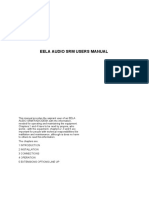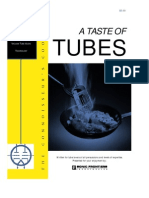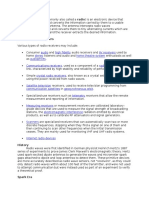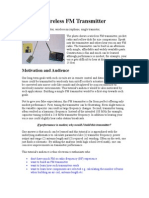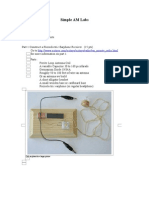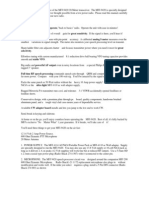FM Crystal Radio
FM Crystal Radio
Uploaded by
Suhendri SaputraCopyright:
Available Formats
FM Crystal Radio
FM Crystal Radio
Uploaded by
Suhendri SaputraCopyright
Available Formats
Share this document
Did you find this document useful?
Is this content inappropriate?
Copyright:
Available Formats
FM Crystal Radio
FM Crystal Radio
Uploaded by
Suhendri SaputraCopyright:
Available Formats
4/16/14
FM Crystal Radio
FM Crystal Radios?
copyright 2006 by Larry J Solomon
I have heard, even from a physicist, that it is impossible to build FM crystal radios. On the other hand some experimenters claim that they have built them. This argument intrigued me to try and build an FM crystal radio, which I have done successfully. To my surprise, the result is an astounding performer, pulling in four local stations in Tucson. When connected as a receiver to a good sound system the sound fidelity is as good or better than more expensive AM radios. In fact, it sounds "high-fidelity".
This picture shows the Solomon FM Crystal Set in an acrylic display case. I made the set specifically to fit inside this case (the case came first). My definition of a crystal radio is one that is not powered, except by the radio transmission itself and employs a crystal detector. So, it should work without any batteries or AC power. An FM crystal receiver must be able to detect and receive FM signals well enough to be heard in earphones without any such extra power. This FM receiver is an amazing performer. It has crystal clear reception (pun intended), good sensitivity, but only fair selectivity. This set was a discovery for me. I started out by designing and building the normal AM sets. Then one day while testing the "Mystery" set (see my other web links), to my surprise, in addition to the expected panoply of AM stations, I heard a very faint signal that I could not tune out. At first, it seemed too weak to identify. When I tuned out all the AM stations, I was astonished to hear the announcement "KiiM FM, 99.5"! This is a country music FM station here in Tucson. It was all over the dial, untunable, but the much louder AM signals masked it when they were tuned in. I set myself the task of trying to improve the FM reception. I tried some simple circuit modifications that did not seem to improve anything. Then I connected a dipole antenna instead of the AM antenna I normally use. Suddenly, the FM
file:///D:/Academic/Physics/Kuliah - 5%/BPenelitian%5D/Dropbox/Study literatur/internet_page/Materi_in_web/FM Crystal Radio.htm 1/11
4/16/14
FM Crystal Radio
signal was much clearer, although still weak. By using the audio output and sound system amplifier, I was even more amazed that four different FM stations came in loud (or rather medium) and clear. I found that changing the telescoping antenna length and position I could tune the stations in and out. They were KRQ, KLPX, KiiM, and KHYT all local FM stations with transmitters nearby. Their reception was also affected by the length and position of the audio output cable. After doing some research, I discovered that there was a physical theory that claimed that FM reception was possible and even probable using the same circuit as an AM receiver. The theory is called "slope detection". So, I set out to find circuit improvements. A web search yielded little, mostly theory. But there was enough information that I thought I could make some modifications to the AM circuits to make them more tunable to FM signals and less tunable to AM. Since FM operates at higher frequencies, all I had to do, I thought, was make the coil and caps smaller. After much "tinkering" I arrived at the current circuit. The circuit looks identical to a classic AM crystal circuit but is even simpler to build. The components were reduced in dimension to resonate at higher frequencies. This was done by experimenting with smaller and smaller coils and capacitors. The antenna is also much reduced in size (from that of AM) to resonate at higher frequencies (the antenna is crucial). The air variable capacitor I used has two trimmers in it which should be adjusted for best reception.I have found that a commonly available vernier dial and knob will fit the capacitor nicely. See end of article for a picture of the variable. C3 is a ceramic capacitor of 18 pf, but may be anywhere from 10 to 50pf. A detected FM signal is converted to AM due to an effect called slope detection that modulates amplitude. This FM Crystal Set works best near the transmitter (I have not tested it beyond about 10 miles). Secondly, the sound level is quiet, especially without an amplifier. A quiet room is needed for listening with earphones. One must be willing to move the set around to find a location for the best reception of signals. However, in addition to listening with high impedance earphones (crystal or otherwise), the set can be connected directly to an audio amplifier's low level magnetic input which can then play amplified through a sound system at any volume -- sounds GREAT. In fact, I recommend starting tests with the FM crystal set by connecting it to the low-level phono inputs of a receiver or preamplifier. (Nowadays, many receivers don't even have a phono input!) That way you can crank up the volume, which makes it more likely to find the FM stations. If no signals are detected, I also recommend connecting an external "rabbit ear" antenna or hanging a short wire (12 inches or so) in various positions next to the internal antenna. The variable length of rabbitt ears can help to tune in stations. No additional wiring or antenna is necessary (the antenna is optimized in length for FM.)
L - 4 turns #18 copper or silver wire, 12mm inside diameter, tapped at 2.5 turns Ant - 7 inches of #18 bare copper wire C1 - 18 pf ceramic capacitor C2 - 50 pf air variable capacitor D - 1N34 diode or rock crystal R - 150K resistor
file:///D:/Academic/Physics/Kuliah - 5%/BPenelitian%5D/Dropbox/Study literatur/internet_page/Materi_in_web/FM Crystal Radio.htm 2/11
4/16/14
FM Crystal Radio
The diode is tapped directly to the antenna. The vernier dial fits directly on the tuning capacitor. The antenna parallels the perimeter of the acrylic face plate. "Military style" #18 AWG wiring is used without any insulation. It is important to keep the components physically close together. The component specifications are the same as in circuit #2. The coil is silver rather than copper, but copper does just as well. I think that the contrast of the silver and copper is beautiful. The coil was wrapped around a Sharpie Permanent Marker, then slipped off and expanded slightly. The wooden base is made from lacquered, polyurethane padouk. I consider this set a work of art as well as science and think it is the most elegant crystal receiver I have created. I love the contrast of the silver coil, the copper antenna, the clear acrylic faceplate, the black vernier dial, the white and transparent variable capacitor, and the subtle colorings on the resistor, the diode, and the lucite base. Yet the circuit is so ridiculously simple that some will not believe it is possible without building it themselves. No shielding is necessary, and there is no problem with hand capacitance. However, the output cable position may affect reception sensitivity. Photos of wired circuit
A hand is included in this photograph to show scale. Note the military style wiring, diode, and antenna. I wanted the wiring to create a modern design similar to a Mondrian painting. Not only is this set beautiful, it works! No power and no long antenna! It looks like a work of fiction.
file:///D:/Academic/Physics/Kuliah - 5%/BPenelitian%5D/Dropbox/Study literatur/internet_page/Materi_in_web/FM Crystal Radio.htm
3/11
4/16/14
FM Crystal Radio
Is this thing imaginary -- science fiction? Well, imagination did play a part, but it is definitely not science fiction. This shot shows the elegance of the FM set best, I think. There is only one resistor and one fixed capacitor.
file:///D:/Academic/Physics/Kuliah - 5%/BPenelitian%5D/Dropbox/Study literatur/internet_page/Materi_in_web/FM Crystal Radio.htm
4/11
4/16/14
FM Crystal Radio
The inside of the tuning capacitor and the phono jack/output can be seen here. Can you spot the fixed ceramic capacitor? Note the polished edge of the face plate and the reflection in the wooden base.
file:///D:/Academic/Physics/Kuliah - 5%/BPenelitian%5D/Dropbox/Study literatur/internet_page/Materi_in_web/FM Crystal Radio.htm
5/11
4/16/14
FM Crystal Radio
A quarter-inch piece of lucite was fitted under the tuning capacitor to anchor it. Note the two tiny trimmers on the back of the tuning capacitor. Brass screws were used to enhance appearance.
file:///D:/Academic/Physics/Kuliah - 5%/BPenelitian%5D/Dropbox/Study literatur/internet_page/Materi_in_web/FM Crystal Radio.htm
6/11
4/16/14
FM Crystal Radio
The vernier dial is large to accomodate ease of tuning, and the vernier makes it easy to separate stations. Two golden (brass) wood screws fix the face plate to the base. Holes for the face plate were made with special plastic drills, but ordinary drills may be used if drilled very SLOWLY. The knob is removable.
FM Crystal Circuit #2
file:///D:/Academic/Physics/Kuliah - 5%/BPenelitian%5D/Dropbox/Study literatur/internet_page/Materi_in_web/FM Crystal Radio.htm
7/11
4/16/14
FM Crystal Radio
L - 5 turns AWG#18 bare copper or silver wire, 12mm inside diameter, tapped at 2.5 turns D - 1N34 or rock crystal diode C1 - 82 pf capacitor C2 - 80 pf air variable capacitor C3 - 18 pf capacitor R - 150K resistor The following photographs show the circuit wired with the handmade Saturn Dial. and knob. It is perhaps not as visually striking as set No. 1, but it works just as well. In fact, this set was the original version. Notice that all the wiring and coil are copper.
file:///D:/Academic/Physics/Kuliah - 5%/BPenelitian%5D/Dropbox/Study literatur/internet_page/Materi_in_web/FM Crystal Radio.htm
8/11
4/16/14
FM Crystal Radio
The Saturn dial and knob were fashioned from a "doll's head" from Michael's Arts and Crafts, a piece of lucite cut with two circle cutters, and a brass paper fastener. The knob is fixed to the tuning capacitor with a small machine screw that fits in the hole below the brass fastener. The most difficult part of this was fashioning "Saturn's rings". This must be done very carefully and slowly. The inside edge should be cut slightly undersized and then sanded with a drum sander to fit snugly. The outside edges can be sanded with fine sandpaper and polished with a plastic polisher.
file:///D:/Academic/Physics/Kuliah - 5%/BPenelitian%5D/Dropbox/Study literatur/internet_page/Materi_in_web/FM Crystal Radio.htm
9/11
4/16/14
FM Crystal Radio
The air variable capacitor may be obtained from Electronix Express at http://www.elexp.com/. Part number 14VCRF10-280P. The 80 pf side is recommended for the second circuit, contacts 2-3. Contacts 1 and 3 were used for the first circuit (50pf). OSC: 5-59 pf ANT: 5-142 pf OSC and ANT Trimmer 10pf range
Home -- If you want to contact me go to the home page and go through the Music Clinic link.
file:///D:/Academic/Physics/Kuliah - 5%/BPenelitian%5D/Dropbox/Study literatur/internet_page/Materi_in_web/FM Crystal Radio.htm 10/11
4/16/14
FM Crystal Radio
file:///D:/Academic/Physics/Kuliah - 5%/BPenelitian%5D/Dropbox/Study literatur/internet_page/Materi_in_web/FM Crystal Radio.htm
11/11
You might also like
- Eela Audio SRM Users ManualDocument14 pagesEela Audio SRM Users ManualJose Carlos SoaresNo ratings yet
- FM Radio ReceiverDocument7 pagesFM Radio Receivermeet_kaur865959100% (1)
- Pe - 1969-11Document118 pagesPe - 1969-11Anonymous kdqf49qbNo ratings yet
- Re - 1980-04Document116 pagesRe - 1980-04Anonymous kdqf49qb100% (1)
- A Taste of TubesDocument67 pagesA Taste of TubesJimmy Page100% (1)
- FDTD Method For em With MATLAB SimulationsDocument453 pagesFDTD Method For em With MATLAB Simulationsaditi monga100% (2)
- ICT SyllabusDocument22 pagesICT SyllabusmmahmoudNo ratings yet
- The Radio Amateur's Hand Book: A Complete, Authentic and Informative Work on Wireless Telegraphy and TelephonyFrom EverandThe Radio Amateur's Hand Book: A Complete, Authentic and Informative Work on Wireless Telegraphy and TelephonyNo ratings yet
- FM Radio ReceiverDocument3 pagesFM Radio ReceiverRajatNo ratings yet
- Radio ReceiverDocument7 pagesRadio ReceiverMarimar BizNo ratings yet
- Expandable Graphic EqualiserDocument6 pagesExpandable Graphic EqualiserCarlos TigseNo ratings yet
- Radio Transmitter: Gomez Abegail Hayag Frank CarloDocument16 pagesRadio Transmitter: Gomez Abegail Hayag Frank Carlofrank1carloNo ratings yet
- MInitransceiver SSB 80mDocument8 pagesMInitransceiver SSB 80mag1tatorNo ratings yet
- 45-860MHz Radio Receiver Based On UV916-tunerDocument7 pages45-860MHz Radio Receiver Based On UV916-tunerSutharsan Kumar Krishnamoorthy100% (1)
- Wireless FM TransmitterDocument11 pagesWireless FM Transmitteranon-73153100% (4)
- Pink Noise Generator For Audio TestingDocument3 pagesPink Noise Generator For Audio Testingmmd3100% (1)
- Lion Cub Scouts Two Tube Radio SetDocument9 pagesLion Cub Scouts Two Tube Radio SetRandom73No ratings yet
- 3V FM Transmitter 3V FM Transmitter CircuitDocument4 pages3V FM Transmitter 3V FM Transmitter Circuitpeter.gomes20087216No ratings yet
- Hammarlund Manufacturing CoDocument20 pagesHammarlund Manufacturing CoDave Whaley100% (2)
- Reflex MW AM ReceiverDocument3 pagesReflex MW AM ReceiverCarlos Molins LopezNo ratings yet
- Broadband TransformersDocument26 pagesBroadband TransformersT100% (1)
- 3 77 PDFDocument68 pages3 77 PDFviatr0nic100% (1)
- Small Radio Transmitter CircuitDocument2 pagesSmall Radio Transmitter Circuitrik206No ratings yet
- Electrostatic Headphones - N. Pollock (Wireless World, Nov 1979)Document5 pagesElectrostatic Headphones - N. Pollock (Wireless World, Nov 1979)jimmy67musicNo ratings yet
- Oscillator BasicsDocument20 pagesOscillator BasicsRizGust Anunnaki100% (2)
- FM TransmitterDocument15 pagesFM TransmitterMuhammad Aiman AmranNo ratings yet
- AOR3000 All ModsDocument22 pagesAOR3000 All ModsdomisoftNo ratings yet
- FM Radio ReceiverDocument5 pagesFM Radio ReceiverRalph DimaandalNo ratings yet
- WWW Talkingelectronics Com Projects LEDTorchCircuits LEDTorchCircuits P1 HTML PDFDocument20 pagesWWW Talkingelectronics Com Projects LEDTorchCircuits LEDTorchCircuits P1 HTML PDFgleand latuniNo ratings yet
- CK701 - 1W Power Amplifier: Circuit DescriptionDocument3 pagesCK701 - 1W Power Amplifier: Circuit DescriptionFuad USNo ratings yet
- Three-Bead-Balun Reflection Bridge 250 KHZ To 1.5 GHZDocument8 pagesThree-Bead-Balun Reflection Bridge 250 KHZ To 1.5 GHZfreddy brigstoneNo ratings yet
- CQ 07 July 1945Document44 pagesCQ 07 July 1945Сергей БезразличныйNo ratings yet
- Beitman 1970 Television TV 1970Document196 pagesBeitman 1970 Television TV 1970Dirceu RodriguesNo ratings yet
- 1T4 Short Wave Three R&E 0351 10pDocument10 pages1T4 Short Wave Three R&E 0351 10pNorman Bourassa100% (2)
- Re - 1972-08Document92 pagesRe - 1972-08Anonymous kdqf49qbNo ratings yet
- The Secret To High Performance Crystal RadiosDocument30 pagesThe Secret To High Performance Crystal RadiosDefEnt100% (2)
- Testing DeviceDocument13 pagesTesting Devicehabtemariam mollaNo ratings yet
- Radio Electronics 1968 05Document92 pagesRadio Electronics 1968 05franciscoNo ratings yet
- User Guide: Constant-Current-Draw AmplifierDocument20 pagesUser Guide: Constant-Current-Draw AmplifierHuythuong NguyenNo ratings yet
- 4 85 PDFDocument68 pages4 85 PDFviatr0nicNo ratings yet
- article-STL Magnetic LoopDocument7 pagesarticle-STL Magnetic Loopemulador05No ratings yet
- Transistor Circuits Manual No 5 Bernard 179 Clive Sinclair PDFDocument34 pagesTransistor Circuits Manual No 5 Bernard 179 Clive Sinclair PDFsantiago962100% (1)
- Radio ReceiversDocument83 pagesRadio Receiversscribd167100% (1)
- Antenna Half Square ArrayDocument8 pagesAntenna Half Square Arraycarlos_gomes_31100% (1)
- Simple Autorange Capacitor Tester / Capacitance Meter With Arduino and by HandDocument7 pagesSimple Autorange Capacitor Tester / Capacitance Meter With Arduino and by HandOussama LabsailiNo ratings yet
- Wireless World 1982 10Document132 pagesWireless World 1982 10jacomartNo ratings yet
- A Survey of Magnetic AmplifiersDocument10 pagesA Survey of Magnetic Amplifiersmartdot73490No ratings yet
- Log Periodic Calculator by KM9ODocument14 pagesLog Periodic Calculator by KM9OSubhanjali Myneni100% (1)
- All Band Large LoopDocument4 pagesAll Band Large Loopbearbullride10100% (1)
- The Operational AmplifierDocument101 pagesThe Operational AmplifierRam MNo ratings yet
- Choke Balun Designs G8ode Iss 1 31Document2 pagesChoke Balun Designs G8ode Iss 1 31fakkurosita100% (1)
- Stabilized Feedback Amplifiers - Harold S. Black (The Bell System Technical Journal, 1934)Document18 pagesStabilized Feedback Amplifiers - Harold S. Black (The Bell System Technical Journal, 1934)jimmy67musicNo ratings yet
- Wireless Weekly 1925-09-02Document51 pagesWireless Weekly 1925-09-02Jan Pran50% (2)
- Tube CAD Journal Jan 2001Document29 pagesTube CAD Journal Jan 2001maher9No ratings yet
- All American FiveDocument12 pagesAll American Fivejaapie666No ratings yet
- What is Charge? – The Redefinition of Atom - Energy to Matter ConversionFrom EverandWhat is Charge? – The Redefinition of Atom - Energy to Matter ConversionNo ratings yet
- The Dawn of Amateur Radio in the U.K. and Greece: a personal viewFrom EverandThe Dawn of Amateur Radio in the U.K. and Greece: a personal viewNo ratings yet
- FM Crystal RadiosDocument12 pagesFM Crystal Radiosjlgg2008100% (1)
- FM Crystal RadioDocument12 pagesFM Crystal RadioMuzza100% (1)
- Simple AM LabsDocument13 pagesSimple AM LabsChristopher BrownNo ratings yet
- ArialDocument13 pagesArialhackinsteinNo ratings yet
- AWP TutorialsDocument5 pagesAWP TutorialsRavi JaiswalNo ratings yet
- Ghana Technology University College: Duration:1Hr Section ADocument11 pagesGhana Technology University College: Duration:1Hr Section ANana Agyeman AntwiNo ratings yet
- Ace Technology XXDWH 17 65S VTDocument1 pageAce Technology XXDWH 17 65S VTVu Minh Duong0% (1)
- 80010805Document2 pages80010805tabordas8797100% (1)
- MFJ 9420Document9 pagesMFJ 9420ovidiu_bNo ratings yet
- Kjsce Te SyllabusDocument46 pagesKjsce Te SyllabusharshNo ratings yet
- Appendix - Antenna PROCOM-CXL-70-3LWDocument3 pagesAppendix - Antenna PROCOM-CXL-70-3LWjanNo ratings yet
- RYMSA RF PresentationDocument39 pagesRYMSA RF PresentationPedro FloresNo ratings yet
- Ansys Capabilities 15.0Document8 pagesAnsys Capabilities 15.0Abhishek PrasadNo ratings yet
- 10 1109@MMS48040 2019 9157319Document4 pages10 1109@MMS48040 2019 9157319Hamza OthmaniNo ratings yet
- Lesson Plan - Antennas and Wave PropagationDocument4 pagesLesson Plan - Antennas and Wave PropagationBilal HussainNo ratings yet
- Ap-3161003 HLDDocument89 pagesAp-3161003 HLDtesseract930No ratings yet
- E01C-Ml01S User Manual: Si24R1 2.4Ghz Spi SMD Wireless ModuleDocument9 pagesE01C-Ml01S User Manual: Si24R1 2.4Ghz Spi SMD Wireless Modulegipsyking2010No ratings yet
- GSN Raju Solved ExamplesDocument95 pagesGSN Raju Solved ExamplesSubham Majumdar0% (1)
- 1.1 BS414 B S - 4: ASE Tation CarrierDocument7 pages1.1 BS414 B S - 4: ASE Tation CarrierEhsan RohaniNo ratings yet
- Antenna EffectDocument5 pagesAntenna Effectstudius1No ratings yet
- Digital Microwave Communication PrinciplesDocument113 pagesDigital Microwave Communication Principleskaz7878No ratings yet
- Ieee Paper On Smart AnteenaDocument3 pagesIeee Paper On Smart AnteenavickeypareekNo ratings yet
- Digitalmicrowavecommunicationprinciples 131014163928 Phpapp02Document113 pagesDigitalmicrowavecommunicationprinciples 131014163928 Phpapp02Ngoy SaroNo ratings yet
- South S82 Extended ManualDocument37 pagesSouth S82 Extended ManualTudor CherhatNo ratings yet
- Cdma Bts3606 AC EDocument51 pagesCdma Bts3606 AC EDaniel JaramilloNo ratings yet
- Sistemas de Comunicaciones IIDocument8 pagesSistemas de Comunicaciones IIAngelDavidGarcesNo ratings yet
- Radio Wave Propagation Fundamentals: M.Sc. Sevda Abadpour Dr.-Ing. Marwan YounisDocument51 pagesRadio Wave Propagation Fundamentals: M.Sc. Sevda Abadpour Dr.-Ing. Marwan YounisjishamvNo ratings yet
- User Manual JetWave 2212SDocument89 pagesUser Manual JetWave 2212SDurga Prasad SharmaNo ratings yet
- An Approach For OTSPR - SubmissionDocument6 pagesAn Approach For OTSPR - SubmissionnstNo ratings yet
- Komunikasi DigitalDocument8 pagesKomunikasi DigitalKhaidir Yazid100% (1)
- UMTS Coverage PlanningDocument55 pagesUMTS Coverage PlanningtadeleNo ratings yet
- Coreless BalunDocument2 pagesCoreless Balunbayman66100% (1)
